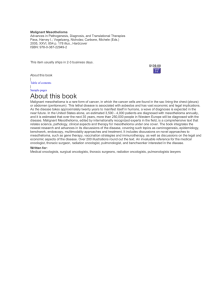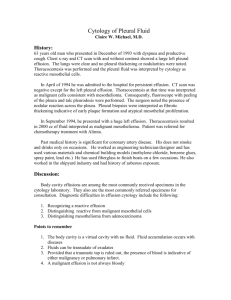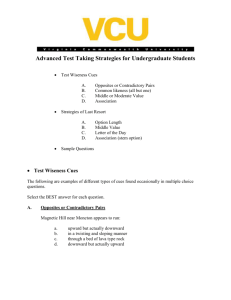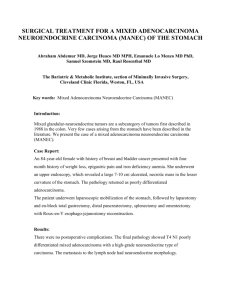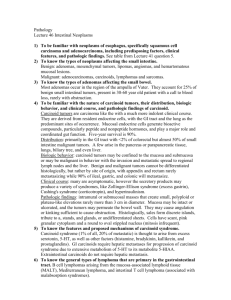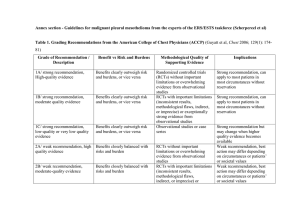Cytology of Body Fluid
advertisement
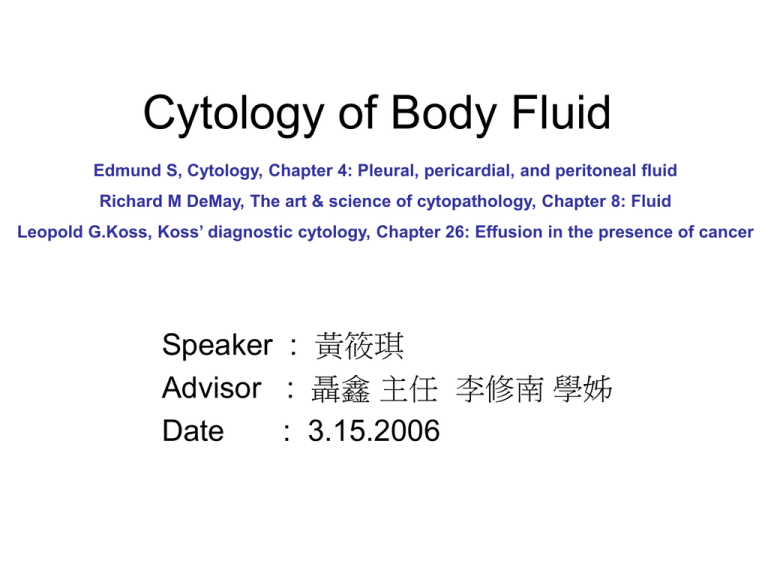
Cytology of Body Fluid Edmund S, Cytology, Chapter 4: Pleural, pericardial, and peritoneal fluid Richard M DeMay, The art & science of cytopathology, Chapter 8: Fluid Leopold G.Koss, Koss’ diagnostic cytology, Chapter 26: Effusion in the presence of cancer Speaker : 黃筱琪 Advisor : 聶鑫 主任 李修南 學姊 Date : 3.15.2006 Outline • Representation of the three body cavities • Collection and preparation of specimen • Benign elements • Non-neoplastic conditions • Malignant effusions---primary tumors ---metastatic tumors • Differences Between Adenocarcinoma and Mesothelioma Schematic representation of the three body cavities Accumulation of fluids in body cavities Transudates • Increased hydrostatic pressure: Congestive heart failure • Decreased oncotic pressure: cirrhosis, nephrosis, and malnutrition (decreased albumin) Exudate • Inflammation: Infection, infarction, hemorrhage • Tumor Differences Between a Transudate and an Exudate Feature Gross appearance Specific gravity Protein Clots Cells Transudate Watery, clear <1.015 <3.0 g/dl No Few; usually benign Exudate Cloudy, reddish >1.015 >3.0 g/dl Yes Many; can be malignant Collection and preparation of specimen Cell block Heparinized bottles (3 units heparin/ml) Adding plasma and thrombin solution Wrapped in filter paper Cytocentrifuge preparation Alcohol-fixed Unfixed Papanicolaou-stained Placed in a cassette Air-dried cytocentrifuge preparation Embedded in paraffin Diff-Quik (Hematologic malignancy is suspected) Cut and H&E stain Benign elements Mesothelial cells • Usually dispersed as isolated cells • Binucleation and multinucleation • Occasional small clusters with “windows” • Dense cytoplasm with clear outer rim (lacy skirt) Mesothelial cells Reactive mesothelial cell • Pleomorphic and enlarged nuclei • Hyperchromasia • Prominent nucleoli • Mitotic figures Benign Mesothelial cells that mimic cancer cells Benign Formation Mimics Three Dimensional cells balls, or rosettes Papillae Indian files Cell in cell Signet ring Single cell Adenocarcinoma Papillary adenocarcinoma Breast, small cell carcinoma Squamous cell carcinoma Breast, stomach cancer Lymphoma Histiocytes • Nuclei often kidney shape • Cytoplasm granular and vacuolated • No window between cells • CD68 positive Other blood cells • Lymphocytes • Eosinophils • Neutrophils • Plasma cells • Red blood cells Non-neoplastic conditions Acute serositis • Bacterial infection: pleural empyema, bacterial peritoneal • Color of the fluid: creamy pale yellow (purulent) • Cytology preparation: high cellular and polymorphonuclear leukocytes Eosinophilic effusions • Thoracic trauma, pneumothorax, hemothorax, pulmonary infarcts • Cytology preparation: high number of eosinophils • Eosinophilic pleural effusions more common • Charcot-Leyden crystals Eosinophilic pleural fluid Tuberculous pleuritis • Color of the fluid: turbid and greenish-yellow • Cytology preparation: high cellular of lymphocytes (T cells) • Differential diagnosis: inflammatory effusion of non-tuberculous origin Tuberculous pleuritis Rheumatoid pleuritis • Necrotizing granulomatous inflammation (joint disease) • Cytology preparation: clumps of granular debris multinucleated macrophages Multinucleated macrophages Systemic lupus erythematosus • Cytology preparation: Lupus erythematosus cell (LE cell) LE cell Malignant effusions---primary tumors Malignant mesothelioma • Clinical history: asbestos exposure, persistent pleural effusions, chest pain • Epithelial (carcinomatous) pattern Malignant Mesothelioma “More and bigger cells, in more and bigger clusters” Group • Irregular papillae and Knobby three-dimensional clusters • Cell-in-cell arrangements • Indian files Nuclei • Increased bi/multinucleation • Nuclear enlargement and pleomorphism • Macronucleoli Cytoplasm • Windows, skirts (lacy appearance) • Dense, many two-tone staining • Fine vacuoles (lipid, glycogen) Cell-in-cell pattern “More and bigger cells, in more and bigger clusters” Malignant effusions---metastatic tumors The Most Common Tumor that Cause Malignant Effusion, by Site and Sex Type of Malignant Men Women Pleural Lung Gastrointestinal tract Pancreas Breast Lung Ovary Peritoneal Intestinal (includes gastric and pancreatic) Pancreas Prostate Ovary Breast Uterus Adenocarcinoma • Large nucleoli • Increased N/C ratio • Secretory vacuoles • Irregular nuclear membranes • Three dimensional aggregates The patterns of Adenocarcinoma Breast cancer • Cannonball (no vacuole) • Indian files • Signet ring cells (small) Ovarian cancer • Psammoma bodies • Cannonball (vacuole) Stomach cancer • Signet ring cells (large) Kidney cancer • Clear cells Thyroid cancer • Psammoma bodies Breast cancer • Cannonballs: Tight packed large balls of cells Smooth borders • Indian files Lung cancer Ovarian carcinoma • Irregular clusters of cells • Large and clear vacuoles Gastric carcinoma • Signet ring cell pattern Clear cell carcinoma of kidney cancer • Clear or granular and vacuolated cytoplasm Papillary carcinoma of the thyroid • Psammoma bodies Squamous cell carcinoma • Keratinized or non-keratinized • Tadpoles and bizarre shape F4.27 Small cell carcinoma • Isolated and molded cells • Scant cytoplasm, inconspicuous nucleoli F4.28 Non-Hodginkin lymphoma Large cell lymphoma • Nuclei large than histiocyte • Eccentric nuclei • Abundant blue cytoplasm • Best appreciated in Diff-Quik Follicular lymphoma • Irregular nuclear contours • Scant cytoplasm lymphoblastic lymphoma • Small to medium sized lymphocytes • Fine powdery chromatin • Scant cytoplasm Small lymphocytic lymphoma • Differential diagnosis: chronic inflammation (tuberculosis) Hodgkin lymphoma • Reed-Sternbery cells: Multinucleated cell with huge inclusion-like nucleoli Multiple myeloma • Single, lack cohesive aggregate • Numerous malignant plasma cells • Immunocytochemistry stain: kappa and lambda light chain (+) CD138 (+) Melanoma • Isolated round cells with prominent nucleoli • Fine brown cytoplasmic pigmentation • Intranuclear pseudoinclusions • Immunocytochemistry stain: S-100(+), HMB-45(+) Sarcomas • Isolated cells Pleomorphic sarcoma Round cell sarcoma Spindle cell sarcoma Osteosarcoma Rhabdomyosarcoma Fibrosarcoma Liposarcoma Neuroblastoma Leiomyosarcoma Large and bizarre shaped Small and uniform shaped Spindle shaped Differences Between Adenocarcinoma and Mesothelioma Cytologic Differences Between Adenocarcinoma and Mesothelioma Adenocarcinoma Mesothelioma Groupings Community borders Windows unusual irregular knobby outline Windows common Cells Columnar shape Blebs, skirts Nucleus Usually eccentric Pleomorphic and bizarre Usually central Less pleomorphic and not bizarre Cytoplasm Delicate, homogeneous Uniform stain Dense with lacy edges Two-tone staining Vacuoles Secretory Degenerative Multinucleated Giant cells Rare Common Distinguishing Between Mesothelioma and Metastatic Adenocarcinoma with Immunocytochemistry Stain Staining patterns Adenicarcinoma Mesothelioma Mucicarmine C + - Carcinoembryonic antigen C + - CA19-9 C + - Leu M-1 C+M + - E-cadherin C+M + - BerEP4 C+M + - B27.3 M + - Thyroid transcription factor-1 (TTF-1) N + - Keratin protein M + (peripheral) + (perinuclear) Calretinin C+N - + Vimentin C - + Wilms’ tumor(WT1) protein N - + C: cytoplasm; M: membrane; N: nuclear E-cadherin BerEP4 B72.3 Calretinin
